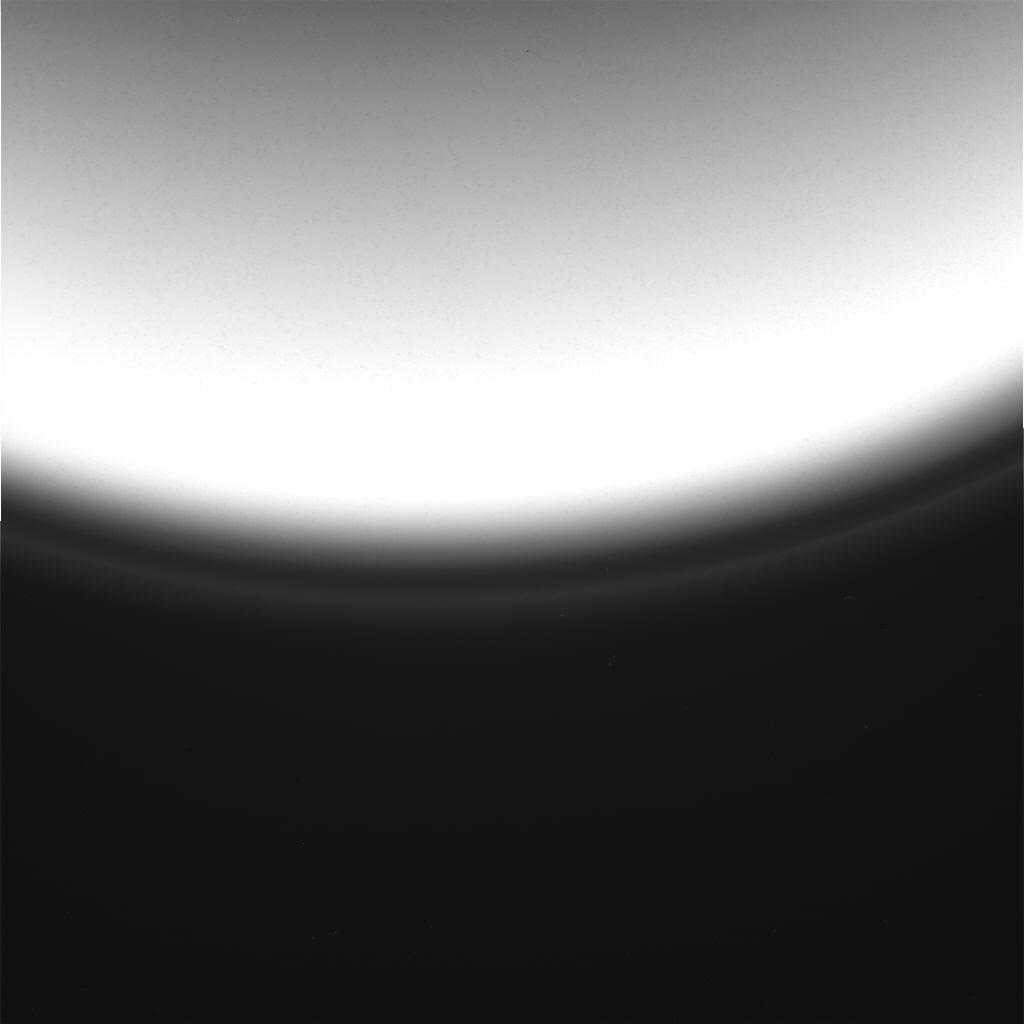November 3, 2023: The Potentially Prebiotic Molecule Malononitrile May Form In The Atmosphere Of Titan
The largest moon of the Gas Giant Saturn has the particularity of containing a significant atmosphere that is completely opaque in the visible spectrum from outer space. That atmosphere of Titan is clearly remarkable for several reasons. First, the atmosphere of the giant moon is dominated by molecular nitrogen like the atmosphere of the Earth. The atmosphere of that exotic world, relatively rich in methane, may resemble the atmosphere of the early Earth. The atmosphere of Titan reveals major differences compared to the atmosphere of the Earth since it contains a relatively significant concentration of methane and since oxygen is absent or almost absent in the gas layer of that intriguing world. Planetologists are particularly interested in the chemistry of the global haze of Titan. That enigmatic haze appears to be rich in hydrocarbons and organics. The ultraviolet light from the Sun can interact with the molecules or the particles present in the upper atmosphere of the giant moon to engender new molecules which can be relatively complex. What type of hydrocarbons or organics can the atmosphere of Titan produce ? That's a major question for planetologists and exobiologists in particular !
A new study entitled "Possible Gas-Phase Synthesis of Neutral Malononitrile (C3H2N2) and Isocyanoacetonitrile (NCCH2NC) under the Upper Atmospheric Conditions of Titan", published on September 8, 2023 in American Chemical Society Earth Space Chemistry and proposed by a team involving Juan C. Ramal-Olmedo, CÚsar A. Menor-Salvan, Akira Miyoshi and Ryan C. Fortenberry reveals the potential mechanisms of malononitrile (C3H2N2) formation in the atmosphere of the giant moon of the Ringed Planet. Malononitrile is a highly reactive molecule that may have played a major role in the process that may have led to the emergence and the development of life on Earth. The researchers of the study believe that the atmosphere of the Orange Moon may represent an ideal environment for the formation and the development of that type of molecule. Let's recall that the gas layer contains relatively significant concentrations of molecular nitrogen (N2) and of methane (CH4). Those fundamental molecules can interact under the action of radiations from the Sun to engender more complex molecules such as malononitrile (C3H2N2) and such as isocyanoacetonitrile (NCCH2NC).
The haze of Titan clearly represents a soup of elements, molecules or compounds that is likely to tell us a lot regarding the chemistry of hydrocarbons and organics in general. Could we encounter sugars, lipids or amino acids in the soil or in the atmosphere of Titan ? In the harsh environment of Titan, chemical reactions will tend to be much slower than on Earth due to the relatively low level of energy received from our star The Sun. However, the formation and the development of complex molecules composed of carbon atoms, hydrogen atoms and nitrogen atoms can be observed. A molecule like benzene (C6H6) can be encountered in the environment of Titan for instance. A molecule like malononitrile may have led to the formation of nucleobases and nucleosides before the emergence of life on Earth. That's why the identification of malononitrile in the environment of Titan would represent a major discovery in the field of planetology and exobiology. Researchers try to understand how that type of molecule can develop in our environment or in the environment of a world composed of a significant atmosphere in the Outer Solar System. The atmosphere of Titan may have all the ingredients for the formation and the development of malononitrile.
The researchers of the study analyze the potential formation mechanisms of malononitrile on the basis of the known composition of Titan's atmosphere and on the basis of the chemicals one can expect in that enigmatic environment. Malononitrile molecules which contain carbon elements, hydrogen elements and nitrogen elements play a major role in the synthesis of heterocyclic compounds and they may have represented a prebiotic molecule in our world before the emergence of RNA molecules. So far, researchers have not been in a position to detect malononitrile in outer space or in the environment of Titan but the abundance of carbonitrile compounds identified in that opaque atmosphere implies that the environment of that giant moon can potentially engender molecules like malononitrile (C3H2N2) or isocyanoacetonitrile (NCCH2NC). The goal of the research work is in fact to evaluate the potential for the formation or the development of that type of molecule in the environment of Saturn's largest moon. The planetologists propose 62 initial gas-phase reaction mechanisms that can engender malononitrile (C3H2N2). Different chemical paths can be envisaged for the production of such molecules !
The team of scientists had to calculate, for the research work, the molecular energies as well as the thermodynamic function values on the basis of the Maxwell-Boltzmann quantum theory. The researchers resorted to several methods to identify the best geometry response that was in line with the level of theory in a configuration of room conditions of pressure and temperature and in a configuration similar to the configuration of the upper atmosphere of the giant moon in terms of pressure and temperature. Simulations were performed across a range of temperatures (80-200 K) and pressures (9.87 * 10-10 to 2.0 atmospheres) in order to determine the most kinetically favorable reaction mechanisms for the production of malononitrile. It turns out that the best reaction for the creation of malononitrile is R8 (1HCCN + 1HNC) with a rate coefficient of 1.08 * 10-11 cm3 molecule-1 s-1, at 145 K and 9.87 * 10-10 atmospheres and a changed Arrhenius expression of k = 1.65 * 10-11 +- 0.005(T/300)0.005 exp(-64.46/T) cm3 molecule-1 s-1. In the soup of chemical reactions taking shape in the upper atmosphere, one can easily imagine that various hydrocarbons, nitriles or organics can emerge.
Various molecules have already been identified by the Cassini orbiter in the exotic atmosphere of Titan. That's the case for hydrogen cyanide HCN for instance. During the interaction process, some molecules composed of carbon, hydrogen or nitrogen can become heavy enough to fall toward the surface where the density and the atmospheric pressure are higher. Some planetologists have imagined that the global haze rich in hydrocarbons and organics can potentially engender a type of snow that will tend to fall to the surface where it can accumulate to engender dunes. The dark areas which mark a sharp contrast with the bright areas in the low or middle latitudes appear to be dominated by linear and parallel dunes extending over long distances. The global haze can fuel those exotic dunes with relatively heavy compounds rich in hydrocarbons or organics. Prevailing winds will tend to have a strong influence on the shape of those dunes that can also interact with methane rain or ethane rain from time to time during the long Titanian year which lasts almost 30 Terrestrial years. The composition of the dunes of Saturn's largest moon is a major research subject. Can they contain prebiotic molecules ?
Some chemical models anticipate the presence of singlet 1HCCN in the upper atmosphere of the giant moon. Isocyanoacetonitrile (NCCH2NC) can be generated in some of the suggested reaction mechanisms. The best reaction mechanism for the creation of that molecule appears to be R2 (C2N2 + 1CH2) with a rate coefficient of 1.20 * 10-10 cm3 molecule-1 s-1 for the corresponding configuration of pressure and temperature with a changed Arrhenius expression of k = 4.48 * 10-15 +- 0.017(T/300)1.862 exp-(-42.44/T) cm3 molecule-1 s-1. Thanks to the Cassini orbiter which had performed a multitude of flybys of Titan during its long mission in the Saturn System from 2004 to 2017, we have been in a position to clearly identify the reactants C2H2 and HCN in the environment of that enigmatic world. The outcome of the study reveals that the large molecule isocyanoacetonitrile (NCCH2NC) may be around one order of magnitude more abundant than malononitrile (C3H2N2) on the basis of a sufficient concentration of 1CH2. Obviously, a myriad of other complex molecules can be envisaged in the harsh environment of Titan where the combination of various elements or molecules can be compared to the combination of Lego bricks to produce new constructions.
The environment of Titan may tell us a lot regarding the chemistry of hydrocarbons and organics, regarding prebiotic chemistry or even regarding life because it appears to have all the ingredients of life. That's why we often say that Titan represents a prebiotic laboratory or a natural laboratory to study the chemistry of hydrocarbons and organics. The Earth contains a key solvent for life that is to say liquid water. Titan can't contain liquid water on its surface due to the extremely low environmental temperatures which evolve around -179 degrees Celsius, - 290 degrees Fahrenheit or 94 Kelvin. However, Titan contains lakes, seas or rivers of methane or ethane in the high latitudes of its hemispheres. Those stable lakes, seas or rivers are likely to engender a complex chemistry involving carbon. In fact, those lakes, seas or rivers can represent solvents for the development of a prebiotic chemistry or even for the development of an exotic lifeform which would not be based on liquid water like on Earth. Beneath the external crust of Saturn's largest moon, pockets of liquid water or a layer of liquid water can potentially be present so that a complex chemistry based on liquid water can also be envisaged.
- To get further information on that news, go to: https://astrobiology.nasa.gov/news/could-malononitrile-form-in-titans-atmosphere/ and https://pubs.acs.org/doi/full/10.1021/acsearthspacechem.3c00107 .

